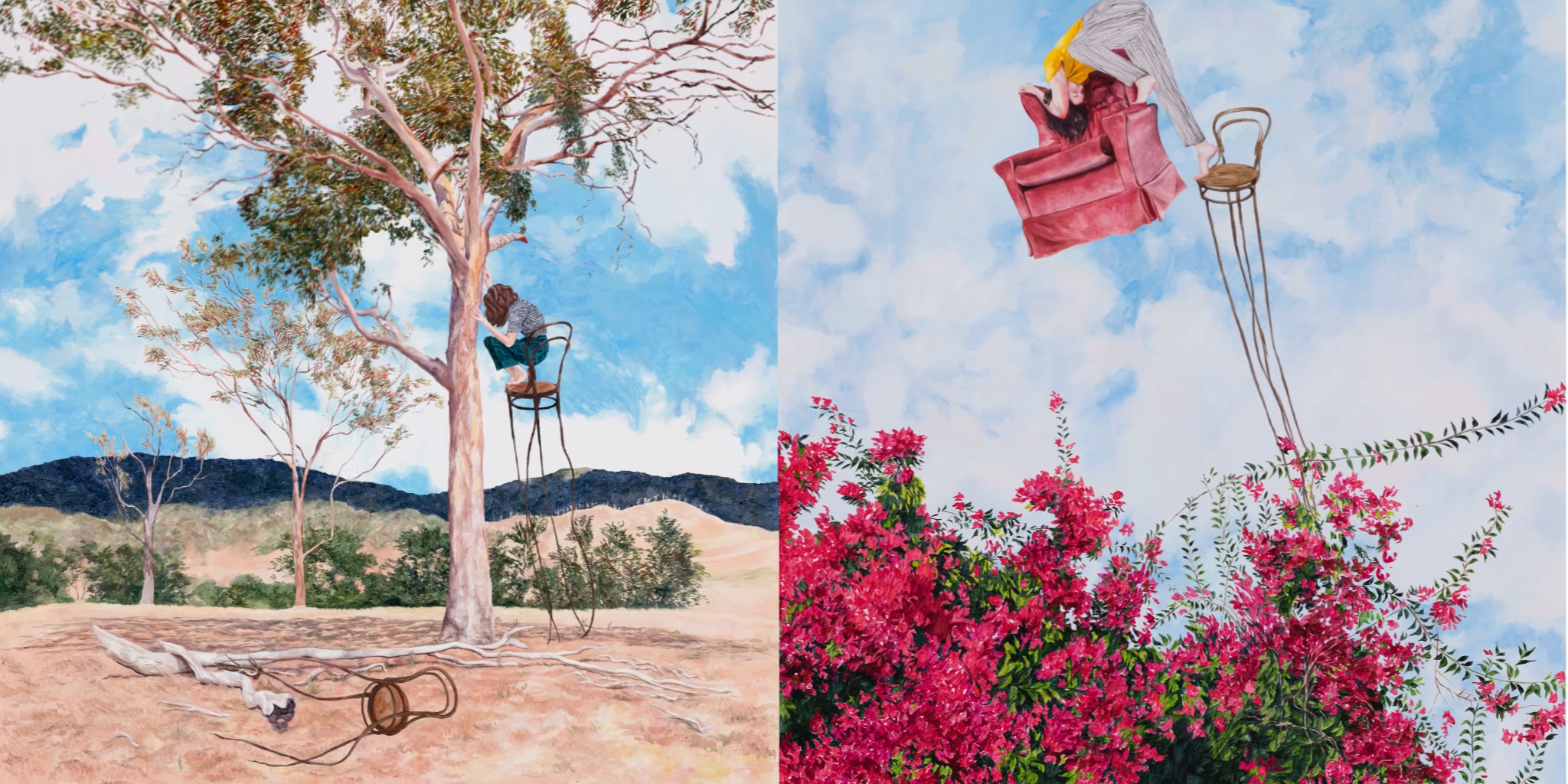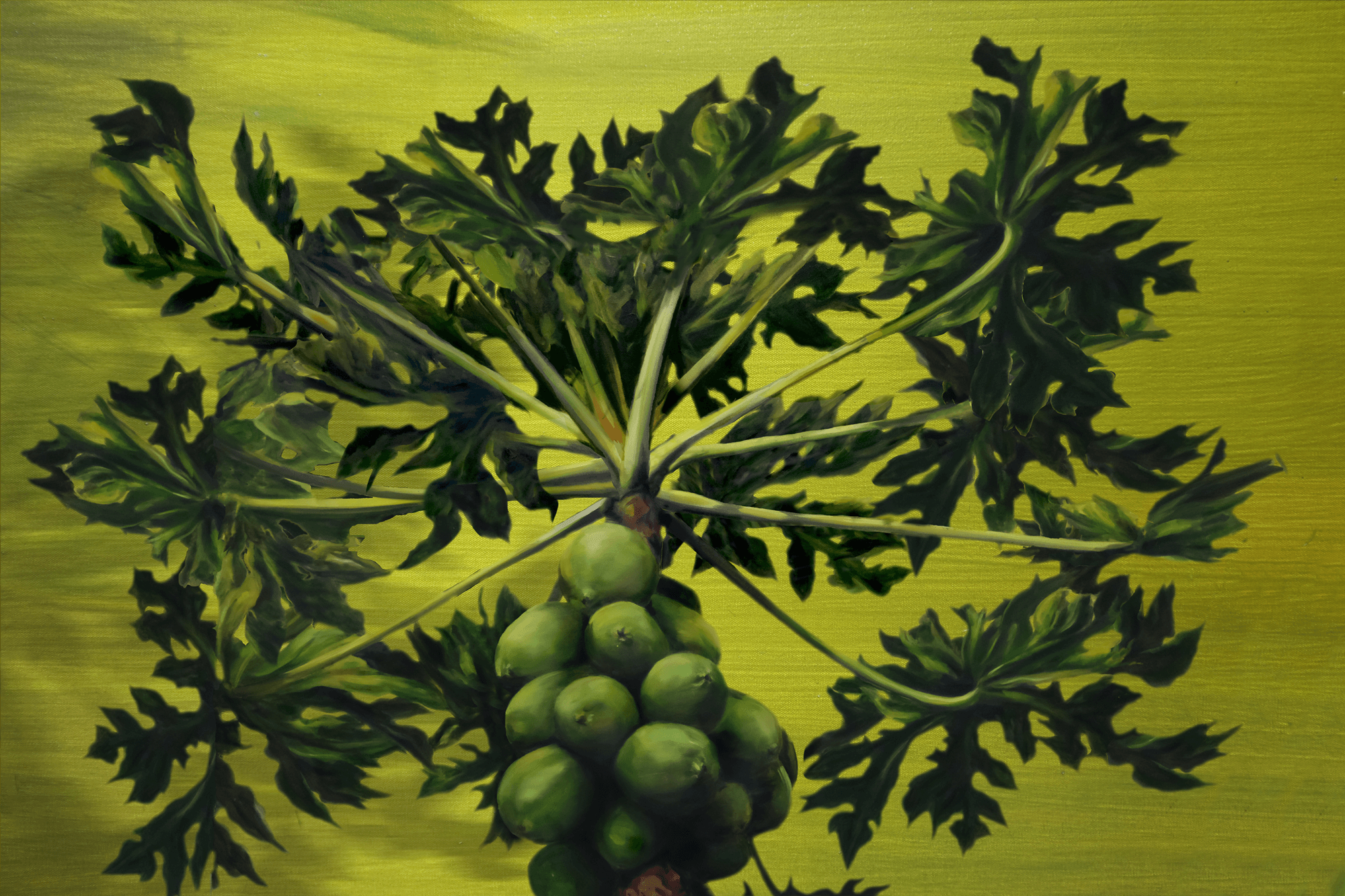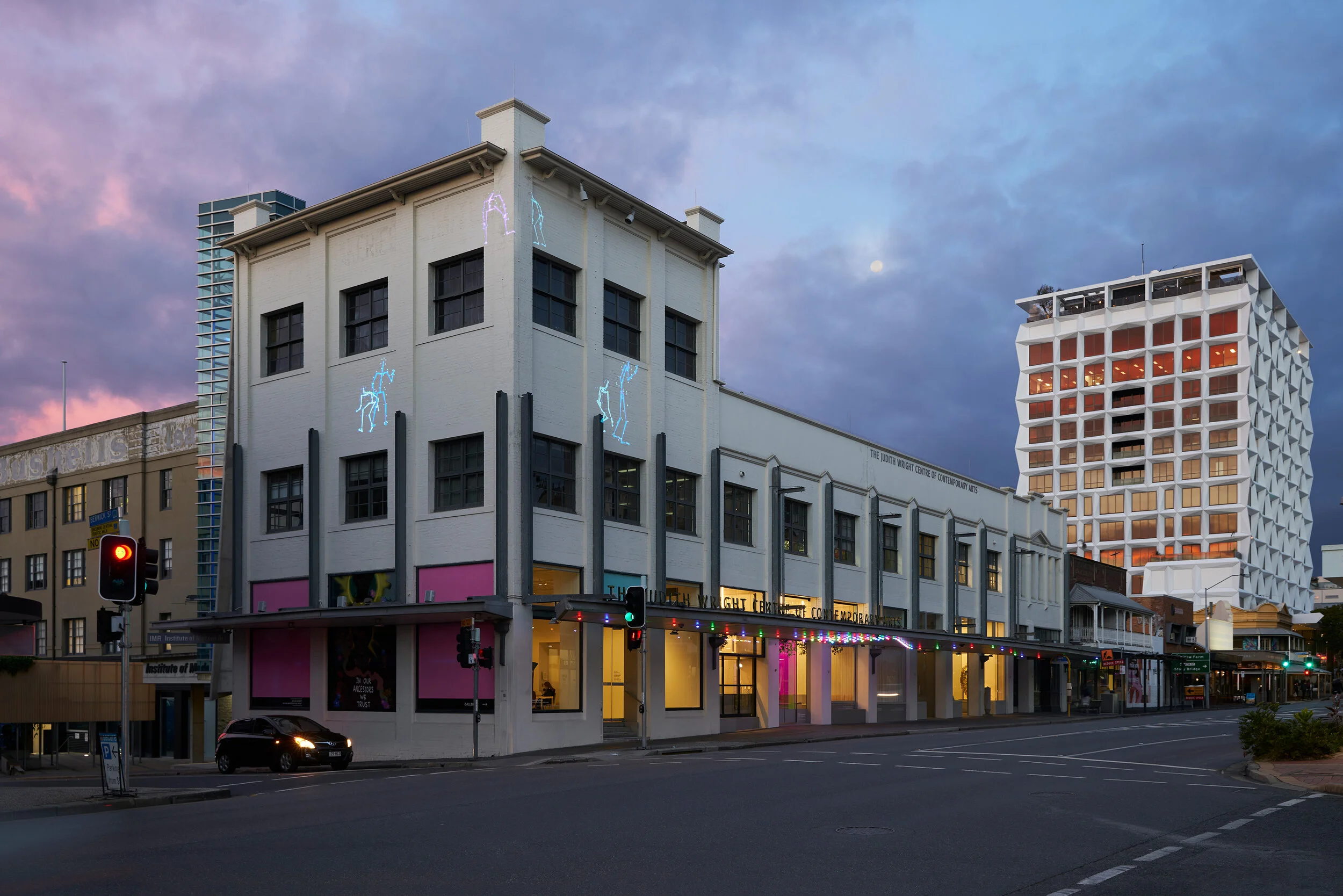Location, Location, Location
Location, location, location seeks to challenge the persisting associations of the urban as a place of centrality by superimposing it with critical reflections on positionality. By harnessing the immovable concrete structure of the Judith Wright Centre of Contemporary Arts, artists were invited to map out their psychogeographical coordinates onto its public-facing façade. As a result, the projections explore the myriad physical, spiritual, and political landscapes we choose or are forced to inhabit and that shape our own unique sense of location or locus.
Now Showing
31 January — 13 February 2022
Monica Rohan, Familiar / Topple (2019)
Floating transcendence and anchored realism share equal magnitude in Monica Rohan’s paintings. Inspired by her rural childhood in South East Queensland, Rohan uses natural space, pattern and light as pictorial devices, where female subjects are positioned in adventurous settings, endlessly floating or falling, climbing or reclining, hunting or hiding.
Since graduating from the Queensland College of Art with Honours in 2011, Monica Rohan has been a finalist in numerous major prizes including the Archibald Prize (2020 and 2016), the Dobell Drawing Prize (2019), Sunshine Coast Art Prize (2018) and the Sulman Prize (2017). In 2015, Rohan’s work was curated into a significant survey show of Queensland artists, Goma Q at QAGOMA. Her work is held in a number of private and public collections, including Artbank, University of Queensland Art Museum, QAGOMA, Museum of Brisbane, Tweed Regional Gallery and the Griffith University Art Museum. She is represented by Jan Murphy Gallery (Brisbane) and Sophie Gannon Gallery (Melbourne).
Previously Shown
17 — 30 January 2022
Sarah Poulgrain, Passing Through (2022)
In Passing Through (2022), Sarah Poulgrain reimagines recent sculptural and video works as a series of playful digital artefacts to invoke a boundless psychological locale where one’s process can continue to evolve, mutate, and adapt without a definite end or format. In conversation with the windows of the Judith Wright façade, digital file windows float against a striking neon blue backdrop, a shade oddly akin to an idle desktop computer screen. On the left, a video window reprises the work 16 in 4 parts (2017) – starring the lively clay bust of the artist’s mother –, while a much smaller window to the right loops the final documentation video of one of three chairs welded by Poulgrain in A Set of New Skills: Chair Making (2019), an evolving project where they seek to learn and share the experience of building new skills alongside other artists.
Poulgrain’s sculptural tyre imprints made by retired Brisbane CityCycle bikes in Aluminum casting (2021) comb across the canvas unannounced, their motion uncannily like the hypnotic trail of one very infamous screensaver. At the same time, a towering desktop window doused in RGB magenta sits in a perennial reboot state. To the right, a file with diaphanous curtains billowing on loop are titled instructively, KEEP LOOKING.
The composite scene re-invents the façade as a mental canvas, where thinking, making and re-making are not considered linear nor permanent. Rather, they are interchangeable parts of a whole operating in continuous motion, like clouds passing through a staunch Brisbane summer day.
Sarah Poulgrain’s art practice considers labour and art. Poulgrain works across video installation, ceramics, sewing, animation and audio production. Their recent work is focused on skill-sharing methodologies as a method to form respectful relationships and create less-hierarchical spaces for learning. Poulgrain has exhibited nationally and internationally including the Institute of Modern Art, Firstdraft, Outer Space, Boxcopy, Metro Arts, Success, Visual Bulk, Bus Projects, RM and Desire Lines, and has co-founded Wreckers Artspace with Hailey Atkins and Anya Swan. In 2019 Sarah received an Australia Council Individual Project Grant to develop new work and has continued work on long-term Brisbane based projects.
Previously Shown
3 September — 16 September 2021
4 — 16 January 2022 (re-screen)
Max Athans, UMBILICAL (2021)
Starting at the most hyper-local place of all, Max Athans’ UMBILICAL addresses the primordial separation of self from site at the origins of life. Here, umbilical cord forms are represented as ouroboric, snakelike shimmering 3D sculptures, their interdependence revealed as they continually dance around the boundaries of others. The work’s abstract nature enables generous space for interpretation: could it illustrate the dependency of individual identity on the sustenance of more collective identities and synergies? And if so, where do these encounters take place?
Max Athans is an artist working between physical and digital material. Their work primarily addresses the mutability of images, digital culture and the instability of history across sculpture, digital image and video. They graduated with Honours from the Queensland College of Art in 2020.
Photography by Cian Sanders
Previously Shown
17 September — 14 October 2021
Judy Watson, death of a warrior in black and white, light and shade (2021)
Dislodging the fragile foundations of colonial sovereignty over Brisbane in 1859 from the temporal bounds of history, Judy Watson retells the hanging of Dala warrior Dundalli in death of a warrior in black and white, light and shade (2021), on the present-day site of Queen Street’s General Post Office.
Dundalli was one of several Aboriginal leaders involved in the debates about how to respond to the land invasion by colonisers in the region. Following conflicts in the Darling Downs and north of the Brisbane Valley in the mid-1840s, attacks and deaths to Aboriginal leaders ensued, fuelling the Aboriginal resistance.
Not far from today’s Judith Wright Arts Centre building, Dundalli was captured in the vicinity of Brunswick and Wickham streets in May 1854, believed to be the sole perpetrator of attacks on a settler station in the Mount Mee foothills and Caboolture river headwaters eight years prior. He was locked up in the female convict factory occupying Queen Street’s present-day General Post Office over winter, and in November 1854 convicted of the murders of settlers William Boller and Andrew Gregor without being allowed to speak in his own defence.
Expanding on previous works where the artist’s research intersected with the life of Dundalli (water under the bridge, 2020) and Aboriginal deaths, both in custody and as result of colonisation (a brief history of colonisation, 1993), Judy Watson’s façade projection recounts the final events in the life of the Dala warrior leading up to his public execution on January 5, 1855.
Judy has drawn upon archival photography and architectural maps in the John Oxley Library and QAGOMA collections, as well as research by University of Southern Queensland Associate Professor Libby Connors in the book Warrior: A Legendary Leader's Dramatic Life and Violent Death on the Colonial Frontier (2015), winner of the Queensland Premier’s Award for State Significance.
Only two historical visual portrayals of Dundalli survive from the time of his trial, and they notoriously underserve his strength and character. In this narrative-driven work, Judy is interested in reclaiming the history of this significant Aboriginal lawman, leader and resistance icon. Judy recounts, “Bob Weatherall had spoken to me about Dundalli a few years ago and I had kept his story in mind as an important one that should be brought to light.” Watson’s projection joins contemporary representations of the Dala resistance fighter, notably Gordon Hookey’s Dundalli Banner (2020) and Ryan Presley’s Blood Money – Infinite Note – Dundalli Commemorative (2016), held by the UQ Art Museum and Museum of Brisbane collections, respectively.
Artist Acknowledgement: the artist would like to thank all artists and parties who helped contribute to and inspire death of a warrior in black and white, light and shade (2021), including: Gordon Hookey, Ryan Presley, Bob Weatherall, Amelia Hine (Outer Space), Alice Maia Rezende (Outer Space), Hamish Sawyer (Outer Space), B J Murphy (cultural consultation), Libby Connors, Sai Karlen, Dhana Merritt, Georgia Boe, Otis Carmichael and Milani Gallery.
Judy Watson was born in Mundubbera, Queensland, and lives and works in Brisbane. Watson's Aboriginal matrilineal family are from Waanyi country in north-west Queensland. Working from site and memory, her work reveals hidden stories within Country, following lines of emotional and physical topography that centre on particular places and moments in time. Judy Watson graduated from the University of Southern Queensland in 1979, the University of Tasmania in 1982 and Monash University in 1986. She has exhibited extensively nationally and overseas, and her works are held in numerous private and public collections including Queensland Art Gallery, National Gallery of Australia, Museum of Contemporary Art Australia, the British Museum, Taipei Fine Arts Museum, and more.
Photography by Cian Sanders
Previously Shown
20 August — 2 September 2021
Rachael Sarra, Heal Country (2021)
To heal Country means to be and protect Country. We are the sand and the sea, the mountains and the sky. We are the contours and the shadows. The spiritual and the physical. We see Country, We smell Country, We hear Country. We are Country.
— Rachael Sarra
Rachael Sarra is an artist and designer whose work is an extension of her being and experiences. As a contemporary Aboriginal artist from Goreng Goreng Country, Rachael uses art as a powerful tool in storytelling to educate and share Aboriginal culture and its evolution. Rachael’s work often challenges and explores the themes of society's perception of what Aboriginal art and identity is.
In 2019, Rachael’s work Two Worlds was projected onto the William Jolly Bridge as part of Brisbane Street Art Festival. She also designed a series of works on a fleet of Brisbane City Council buses to celebrate NAIDOC Week that can be seen circulating the city today. Rachael has had the pleasure of working with clients such as Australia Post to design the 50th Anniversary of the 1967 Referendum postage/collectable stamp. She was also the lead artist for the Suncorp Super Netball, Queensland Firebirds Indigenous dress, and has collaborated with Tourism Australia, Matrix and Hardie Grant.
Rachael graduated with a Bachelor of Visual Communication Design from the Queensland College of Art in Brisbane. Rachael is fueled by passion to continue exploring her Aboriginality through art and design, with each piece strengthening her identity.
Photography by Cian Sanders
Previously Shown
9 — 19 August 2021
Bella Deary, Rise (2021)
Rise interrogates the threat of rising sea levels in the global South. Tides are depicted gradually climbing the Judith Wright Centre façade, the ocean waves submerging a fictional clay map indicating islands within this region. Clay masses are displaced and removed by the effects of the water with the exception of the topmost formation, its shape suggestive of the Southern coastline of Australia. The work aims to call Australian Government leaders to action, advocating for the implementation of climate policies that will protect the futures of global communities.
Bella Deary is a Meanjin, Brisbane-based visual artist whose practice gathers influence from environmental science and climate activism to promote the equality of all living forms. Bella uses latex sculptures and video projection to create immersive and interactive installations. Central to Bella’s practice are notions that conjure up relationships between human bodies and other natural life, alongside the poetic communication of scientific content. Her work expresses important ecocentric concepts and aims to dismantle the hierarchy between humans and the natural environment.
Photography by Cian Sanders
Previously Shown
23 July — 8 August 2021
Lisa Kurtz, Uneasery (2021)
Uneasery is part of a series exploring how human spaces operate differently to natural spaces. A visual representation of my own odd and awkward relationship with nature, these works use the building as a host, crossing from one space to the other. Equal parts a balm for the city and a subversion of our attempts to wrangle nature.
Lisa Kurtz is a Brisbane-based emerging artist whose work explores concepts of memory, place and time. Using the photograph as temporal artefact, Kurtz explores latent and disrupted spaces, asking what we want from the experience of looking at a photograph.
Photography by Cian Sanders
Previously Shown
9 — 22 July 2021
Christopher Bassi, Grow (2020)
In the painting series Passages (2020), Christopher Bassi highlights the idea of transversing locations as a recurrent mode of living. Tightly framed in the picture plane, his depictions of archipelago fruit and fauna – exemplified in Grow by a densely foliaged paw paw tree – reflect on the wide-spanning transcoastal journeys of his Meriam and Yupungathi ancestors from the Torres Strait and Cape York, and eventual settling on Thursday Island. Through pictorial representation, Bassi looks to capture abstract concepts of mobility and flow between people, seascape and landscape which are essential to Torres Strait Islander identities.
Christopher Bassi is an Australian artist of Meriam, Yupungathi and British descent. Working predominantly with archetypal models of representational painting, his work is concerned with the potential to address concepts of cultural identity, alternative genealogies, counter narratives and speculation within the art historical language of painting.
Approaching painting as a means of storytelling, with narrative intent akin to literature or poetry, his work sets the stage for history and heritage to become the foundation of a personal cosmology that explores concepts of place, belonging and the entangling of racial and cultural identities, while also researching into the extent of the painted image as a system that is socially coded and embedded within the historical legacies of the Western art history cannon.
Tropical flora is a recurring subject in Bassi’s paintings. Certain plants become symbols of shared climates, cross-cultural experiences and a shifting idea of ‘home’. Notable past exhibitions include Documents of Distance, Stable Art Space (2018); Placement: Monica Correa and Christopher Bassi, Spiro Grace Art Rooms (2017); Futureproof, Boxcopy (2018); Cross-Mending, Outer Space (2018); The Garden and The Sea, CARPARK (2021); and City in the Sun, Museum of Brisbane (2021). His work is held in a number of collections, including the Museum of Brisbane.
Photography by Cian Sanders
Previously Shown
25 June — 8 July 2021
Catriona Drummond, Sweaty Saturday (2021)
Sweaty Saturday depicts a Saturday night scene on West End's Boundary Street, translating the street’s contemporary hybridity into an animated illustration replete with idiosyncratic characters. The area of Boundary Street outside Archive demonstrates a laissez-faire approach to urban development in the face of expanding commerce. In Sweaty Saturday, we see the strip’s mounting parallel universes: mobile app delivery drivers convening on the carpark edge, the ancient cop shop in the old Queenslander, and a constant stream of bar-hoppers. On a hot Brisbane night, sweat may be the only equalising agent of these disparate human realities.
Catriona Drummond is an art director and visual development artist from Brisbane. She's worked extensively in animation around Australia for advertising and television, as well as self publishing comics and illustrations. She is best known for her work as lead art director for season 1 of ABC’s smash hit Bluey.
Photography by Cian Sanders
Previously Shown
11 — 24 June 2021
Lacey-Law-Lobwein, Street View (2021)
In Street View, the collective Lacey-Law-Lobwein (LLL) consider the ways in which computers and algorithms attempt to map human bodies, while simultaneously stripping them of unique identifiable characteristics. Employing motion-capture technology to render moving 3D skeletons, LLL question the constant processes of data capture and collection that occur in public spaces. The dual perspective of the skeletons projected on either side of the façade provides an imagined X-ray view of the activity taking place inside, emphasising the constant and pervasive nature of spatial surveillance.
Lacey-Law-Lobwein (LLL) is a collective of three early career artists who share a background in screen-based media. Olivia Lacey employs processes of transcription and translation to explore how ambiguities, slippages, or humour can arise in interpersonal interactions. Her work combines referents appropriated from pop music lyrics in order to examine the romantic dialogue as an intersubjective space of exchange. Briony Law works primarily with moving image and installation. Her practice explores aspects of human ecology and systems of mediation, and the potential of mediation to inform attitudes toward ecology. Guy Lobwein is currently undertaking his Doctorate of Philosophy at Queensland University of Technology, whose research focuses on the use of expanded reality technologies in contemporary art and how experimental creative practice can generate experiential and critically reflective experiences. LLL were recently selected to participate in Common Ground, an exhibition exchange between Metro Arts, Brisbane and Bus Projects, Melbourne.
Photography by Cian Sanders
Previously Shown
28 May — 10 June 2021
Erin Dunne, Drawn Together (2020)
Borrowing the scrolling aesthetic of a LED stock market ticker, Erin Dunne reconfigures their work Drawn Together to engage in dialogue with the medium of projection. The eighteen-metre long woven linear narrative offers an autobiographical account of contemporary life in rural and regional Central Queensland, deploying the artist’s queer gaze to disrupt metronormative assumptions that queerness cannot be found or flourish beyond the urban. By ‘rural-bombing’ Queensland’s capital city, Drawn Together also functions as an ironic ‘sell’ of alluring greener pastures.
Erin Dunne is an artist and arts educator based in Central Queensland on Darumbal Country. Their work attempts to capture and distill a poetic and narrative sense of what it means to call regional Central Queensland home by examining everyday experiences related to place through an autobiographical lens.
Photography by Cian Sanders
Previously Shown
14 — 27 May 2021
Screening again 29 — 31 October 2021
Lucy Nguyễn–Hunt, things I can't say / những điều tôi không thể nói (2021)
Translation Credits: Ashley Van, Joyce Cheng, Linda Nguyễn, Tram Phan, Trí Thanh Nguyễn and Vân Nguyễn-Hunt.
Two significant art spaces in Brisbane, the IMA and QCA PoP Gallery, situated on the same street, were sites of my personal queer realisation, validation, and trauma. I outed myself to my mother through my own very ~gay~ art on Brunswick street, and when I was met with the opposite of “I love you no matter what”, I felt the pain so strongly it broke the fake ID I had assumed for so long. The colonial binaries of memory forbid me from perceiving the event or what it truly was; healing and heart-breaking. When I think of location through a queer lens, I think of the duality of queer trauma and affirmation that can exist within a space; an experience that is liminal and not always, but sometimes complicated. things I can't say / những điều tôi không thể nói sees Vietnamese signage and store fronts as a façade, but also barriers and thresholds. A facade of glimmering neon desire is barricaded by Vietnamese/English reflections and sentiments, as well as questions posed in the past. As an intersectional identity existing somewhere between Australia and across oceans, I lack the words to express my true self or describe queer experiences in my mother’s tongue. What implications does this create in self-expression, validation, and belonging?
— Lucy Nguyễn-Hunt
Lucy Nguyễn-Hunt is an interdisciplinary Vietnamese and Samoan/Cook Islander Australian artist with an abiding passion for sharing lived experiences through a cultural dialogue. Namely, this manifests as dismantling preconceived notions of identity through the lens of a camera and the culturally hybrid and queer gaze. Working predominantly in photography and moving image, Nguyễn-Hunt investigates the oppressive structures in place which consistently reinforces the “othered” body and self. Using her artistic practice as a safe space for licking her wounds, Nguyễn-Hunt works to prioritise self-representation and visibility through a process of self-negotiation and preservation.
Photography by Cian Sanders
Judith Wright Arts Centre building façade
5:30pm — 11:30pm daily (during exhibition period)
420 Brunswick Street
Fortitude Valley QLD
(map here)
Note: this exhibition is viewable from the outside of the gallery.
 |
This project has been assisted by the Queensland Government through Arts Queensland. |














































































